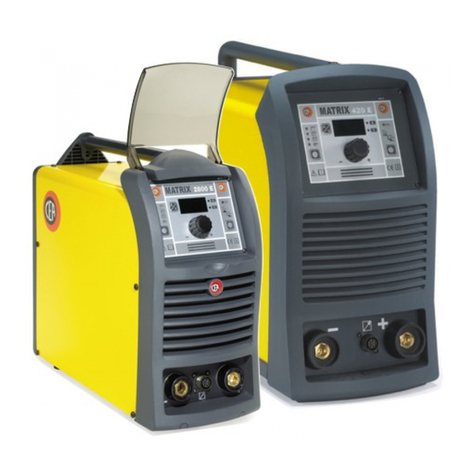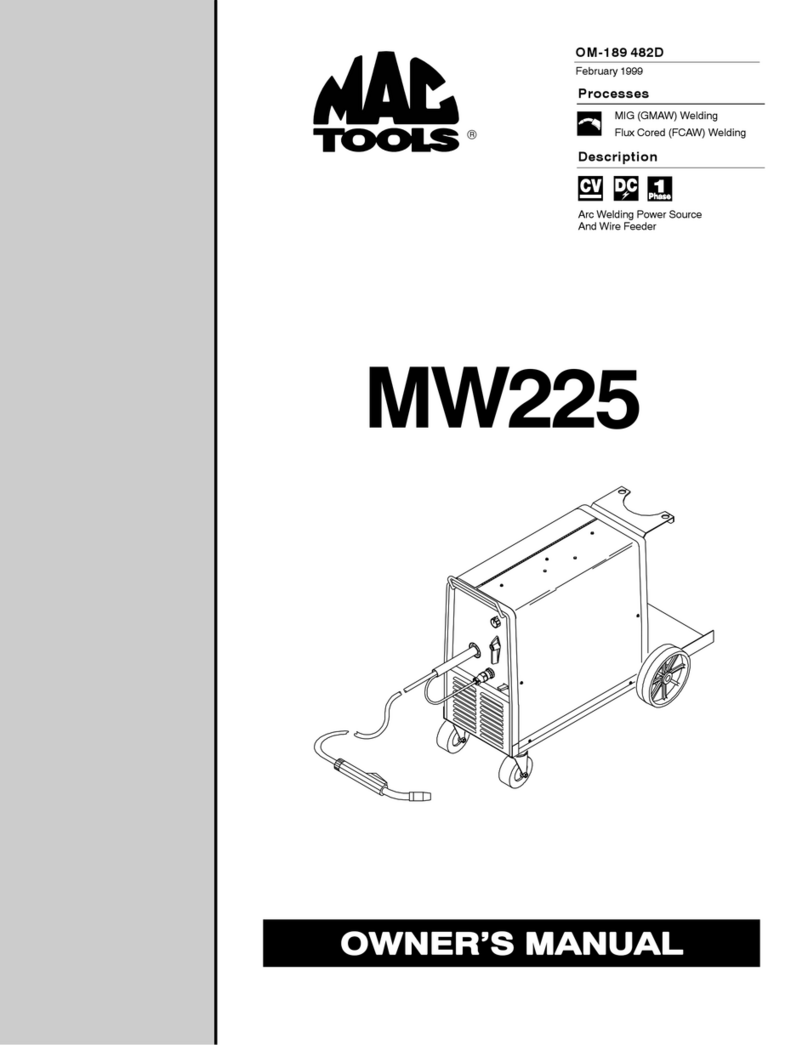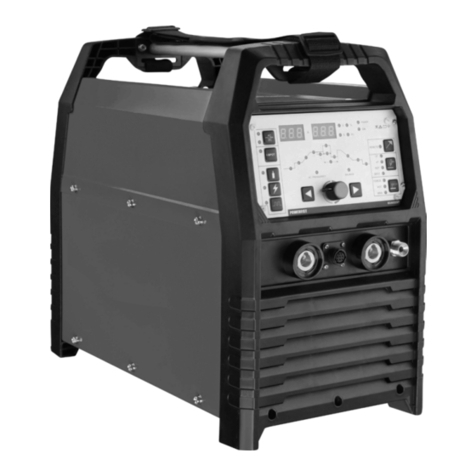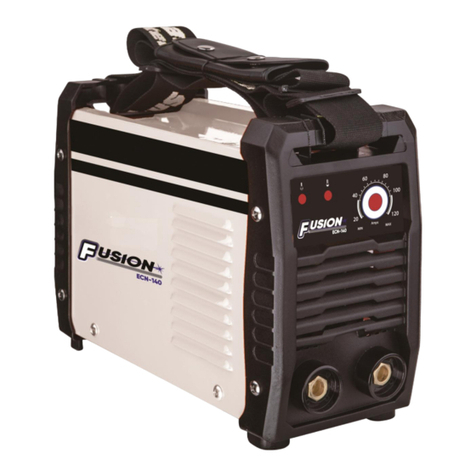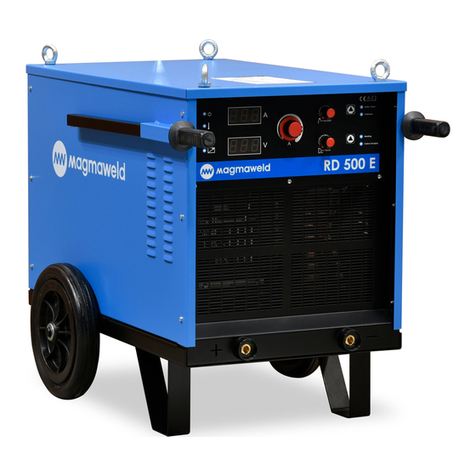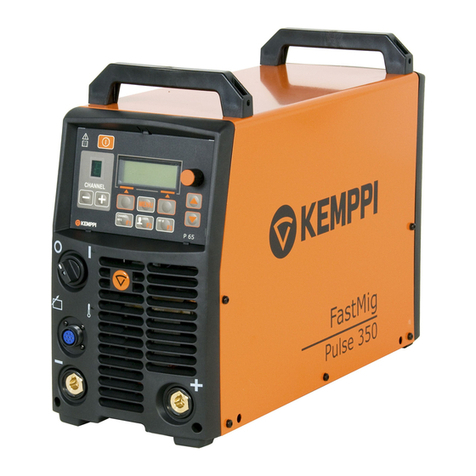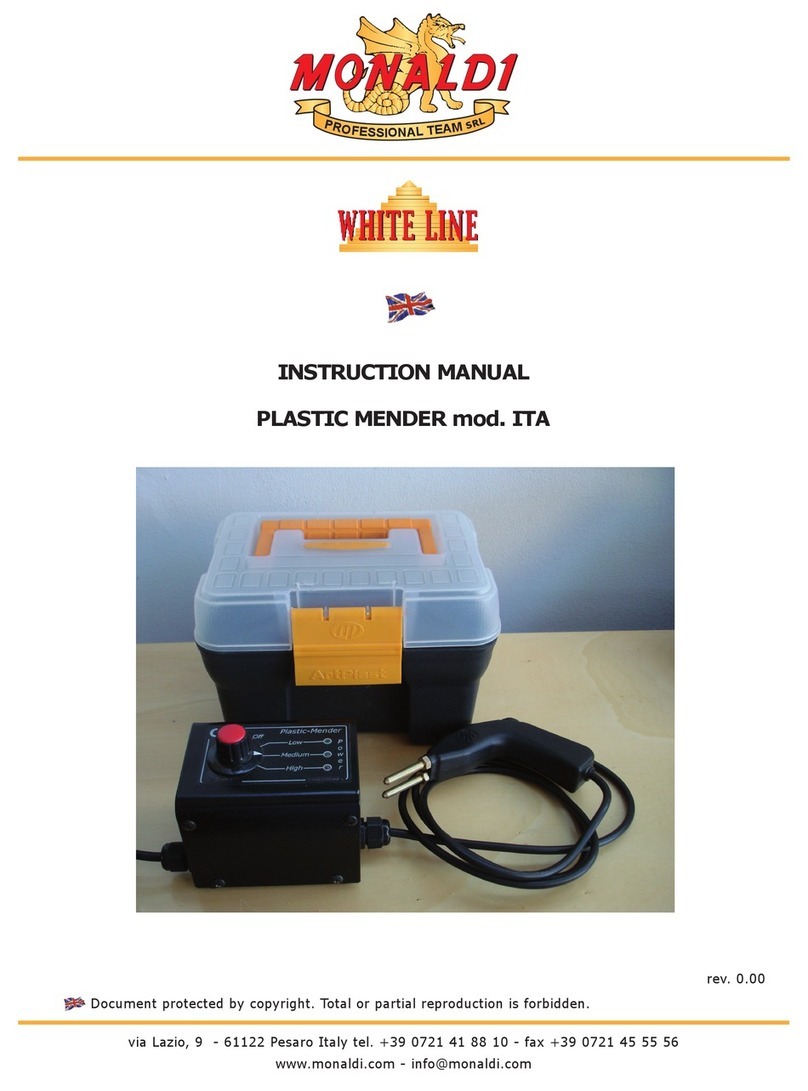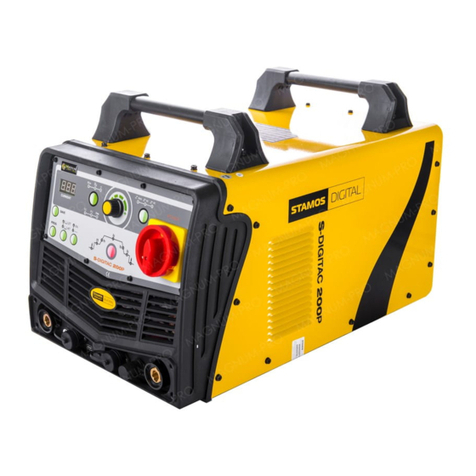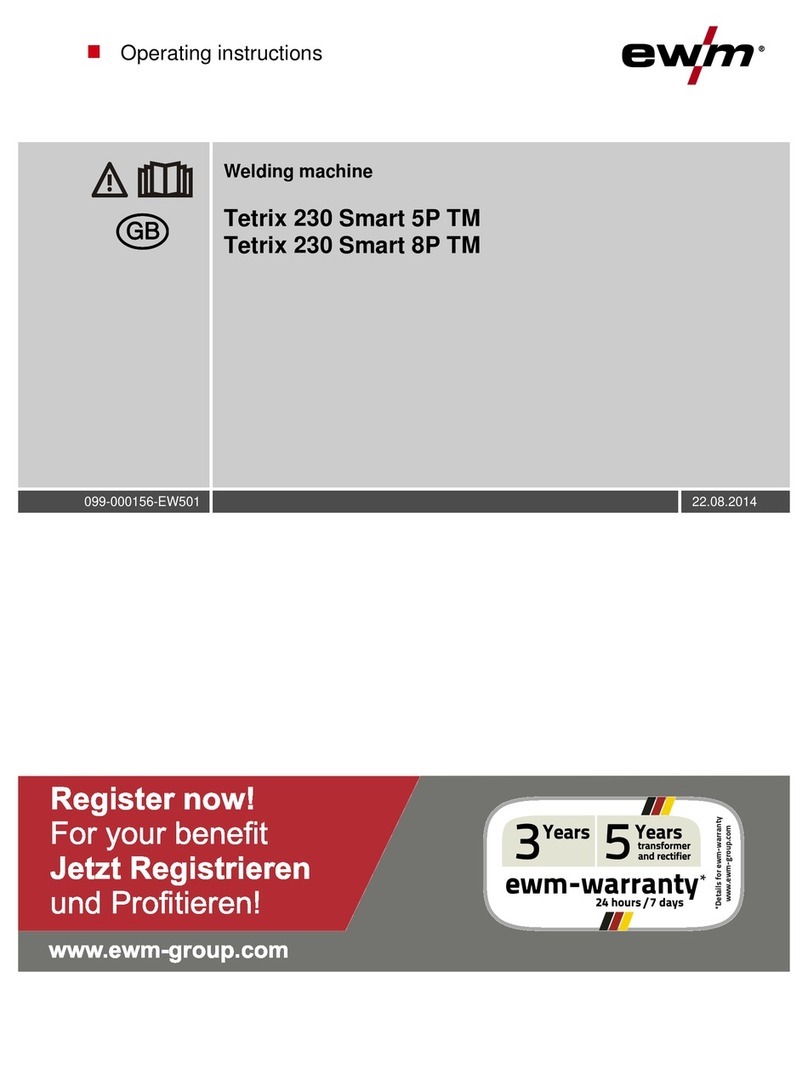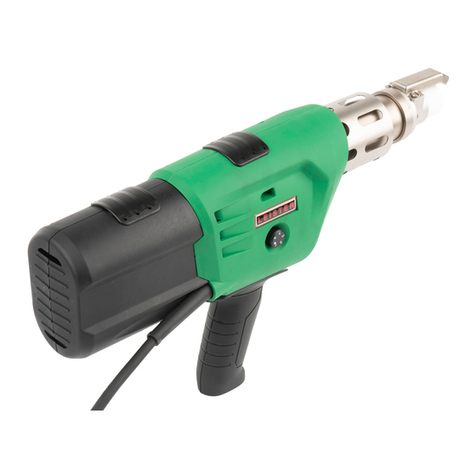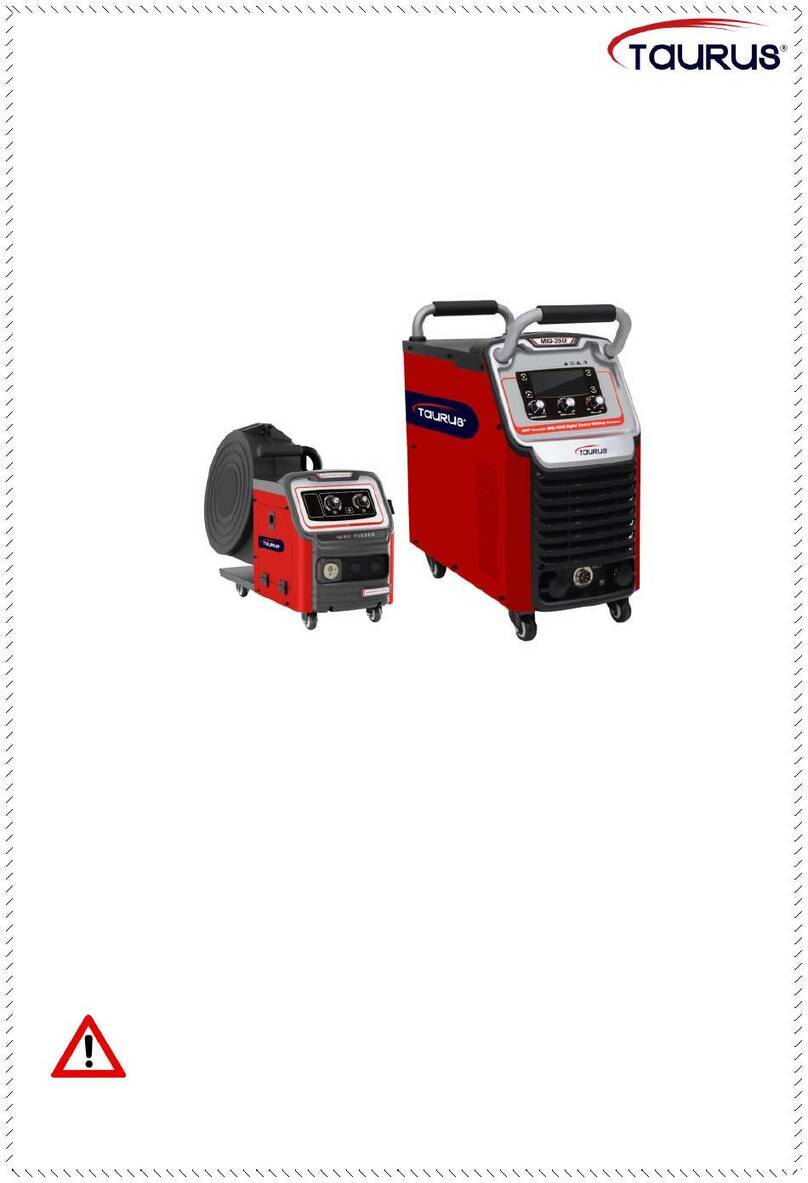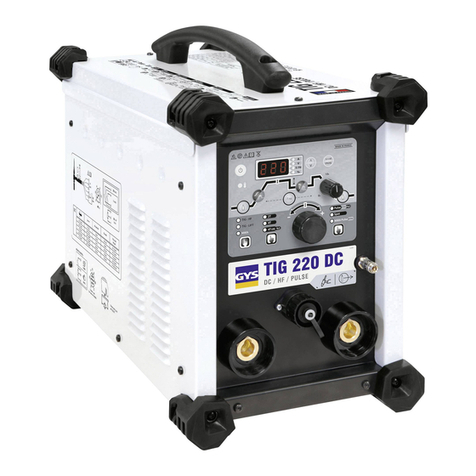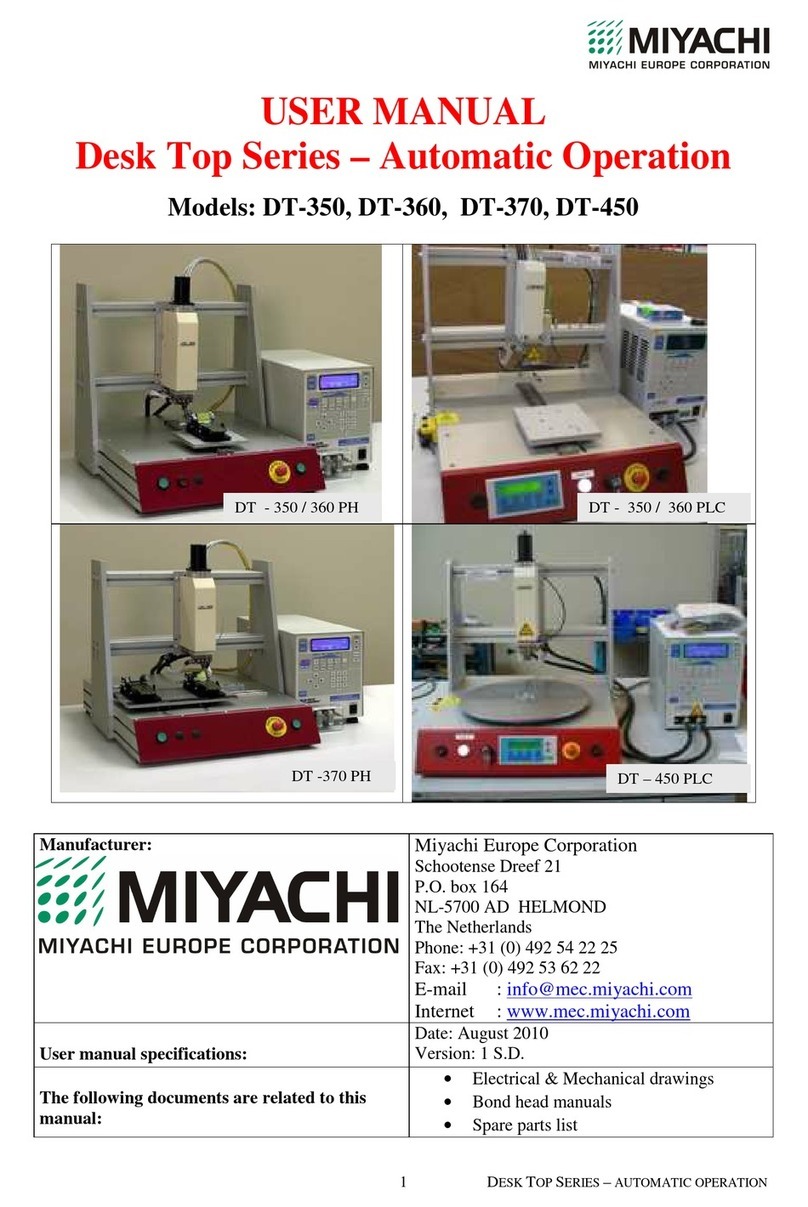MIDWEST FASTENERS SURE SHOT II User manual

Wld SureShotII Manl_Cvr01.fh1 3/5/13 7:52 PM Page 1
C M Y CM MY CY CMY K
Hand Held – Capacitor Discharge
Welding System
Owner’s Manual

4VSF4IPU**
$%
4UVE8FMEJOH4ZTUFN
0XOFST.BOVBM
t*OTUBMMBUJPO
t0QFSBUJPO
t.BJOUFOBODF
.*%8&45'"45&/&34*/$
3JDIBSE4USFFU
.JBNJTCVSH0)
1IPOF
'BY
ª.JEXFTU'BTUFOFST*OD"MM
SJHIUTSFTFSWFE
1SJOUFEJO
64"

¥
.*%8&45'"45&/&34*/$
4VSF4IPU**4UVE8FMEJOH4ZTUFN
Warranty
...........................................................................................
2
Safety Precautions
............................................................................
3
What is CD Stud Weldin
g
...............................................................
5
Overview
..........................................................................................
7
Installation
........................................................................................
8
Set
up
Setup
Set
................................................................................................
9
Power
-Up and Adjustment
.............................................................
-Up and Adjustment .............................................................
-Up and Adjustment
11
Making Test Welds
.........................................................................
12
Weld Joint Quality
........................................................................
12
Preventive Maintenance
.................................................................
13
Troubleshooting
.............................................................................
13
Controller Specifi cations
................................................................
16
Weld Gun Specifi cations
...............................................................
16
Controller
Exploded View & Parts List
........................................
17
Weld Gun Exploded View & Parts List
.........................................
Weld Gun Exploded View & Parts List .........................................
Weld Gun Exploded View & Parts List
19
Electrical Schematic
.......................................................................
20
Notes
..............................................................................................
21
5"#-&0'$0/5&/54
(&/&3"-
*/530%6$5*0/
4&56101&3"5*0/
."*/5&/"/$&
1"35441&$*'*$"5*0/4
FOREWORD:
Your new stud welding equipment is carefully constructed of the fi nest components and materials available.
Used properly, this equipment will give you years of profi table, effi cient Service. The system incorporates the latest in
engineering advances for completely reliable welding of mild steel, stainless steel
and aluminum
. The electrical and
mechanical components of the stud welder are thoroughly performance inspected prior to assembly in the welder. The
assembled unit is completely performance checked. The welder is delivered to you in functional electromechanical condition.
A careful study of this manual will enable you to understand how the welder operates to insure proper performance unde
r
all operating conditions.
WARRANTY: All parts used in the assembly of your MIDWEST FASTENERS S
ureShot II Welding System are fully
guaranteed for three (3) years from factory shipment date.
Under this warranty, MIDWEST FASTENERS reserves the right to repair or replace, at its option, defects in material or workmanship
which occur during the warranty period. Notice of any claim for warranty repair must be furnished to MIDWEST FASTENERS
within ten (10) days after the defect is discovered. MIDWEST FASTENERS does not assume liability for shipping, or liability for
any labor or material related to use of this system unless such costs are expressly authorized in writing by MIDWEST FASTENERS.
MIDWEST FASTENERS, INC. does not warrant defects in welders, parts or accessories resulting, from abuse, improper
installation, or for reasons beyond its control.
This warranty is valid only when welding pins an
d
/or studs approved by or purchased from MIDWEST FASTENERS.

¥
.*%8&45'"45&/&34*/$
4VSF4IPU**4UVE8FMEJOH4ZTUFN
8&-%*/(4"'&5:13&$"65*0/4
"/%8"3/*/(4
INSTALLATION AND SERVICING SAFETY
Improperly installed or improperly grounded
equipment is a hazard. Always have qualifi ed
personnel perform the installation, trouble-shooting,
and maintenance. Do not perform any electrical
work unless you are qualifi ed to do the work. Be
sure the system is properly grounded.
Maintain this unit according to the manual.
Disconnect input power before servicing this
equipment and use lockout tags. Signifi cant DC
voltage can still exist in this equipment after removal
or shut down of the input power. Turn off all
equipment when not in use.
ELECTRICAL SHOCK HAZARD
Contact with live electrical parts and ground can
cause severe injury or death. DO NOT weld in damp
areas or while equipment or clothing are damp or
wet. Do not touch the stud if you are in contact with
the work, ground, or another electrode from a
different machine. Don’t stand directly on metal or
the earth; stand on dry boards, insulating mats or an
insulating platform.
Before turning on power, be sure you are wearing
appropriate protective clothing:
- high-topped, heavy rubber-soled shoes
- long (gauntlet style), dry, fl ameproof, hole-free
insulated gloves
- heavy, long-sleeve, cuffl ess shirt
- heavy, cuffl ess trousers and
- a welding helmet or cap.
GENERAL WELDING JOB SAFETY
Use this equipment only for its intended purpose.
Use well-maintained equipment. Replace worn or
damaged cables or parts immediately; bare wiring
can kill. Do not drape cables over your body. Keep
all panels and covers securely in place. Do not
overload electrical wiring, be sure power supply
system is properly sized, rated and protected to
handle the unit. Don’t connect multiple guns or work
cables to a single weld output terminal. Follow rated
duty cycle and allow overheated equipment adequate
cooling periods. Do not block or fi lter airfl ow to
unit.
DO NOT weld if movement is confi ned or if there is
danger of falling. Wear a safety harness if working
above fl oor level. Shut unit down and remove weld
stud from the stud weld gun when not in use.
ELECTROMAGNETIC FIELDS AND
EMF
Electric and magnetic fi elds may be dangerous.
Welder operators having pacemakers should consult
their physician before welding. EMF may interfere
with some pacemakers. Exposure to EMF may have
other health effects which are unknown. Connect the
work cable to the work piece as close as possible to
the area being welded. Keep welding power source
and cables as far away from your body as possible.
Electromagnetic energy can interfere with sensitive
electronic equipment such as computers and
computer-driven equipment such as robots.
FUMES HAZARDS
Welding produces fumes and gases. Breathing these
fumes and gases can be hazardous to your health,
particularly in confi ned spaces. Do not breath fumes
and gases. Always ventilate confi ned spaces or use
approved air-supplied respirator. Welding on coated
metals such as galvanized, lead or cadmium plated
steel can be hazardous, in terms of fumes produced,
unless the coating is removed from the weld area.
Don’t weld near degreasing, cleaning or spraying
operations.
FIRE SAFETY AND BURN PREVENTION
(ARC RAYS CAN BURN EYES AND SKIN)
Always wear safety glasses with side shields in any
work area. Even if wearing a welding helmet, face
shields and goggles are also required. Wear goggles
over safety glasses when chipping, wire brushing or
grinding slag. Chipped slag may be hot and can fl y
far. Bystanders should also wear goggles over safety
glasses. Use protective non-fl ammable screens or
barriers to protect others from fl ash and glare.
Warn bystanders not to watch the arc and not to
expose themselves to the rays of the electric-arc or
hot metal.
Welding on closed containers, such as tanks, drums
or pipes, can cause them to blow up. Do not weld
where fl ying sparks can strike fl ammable material.
Remove all combustible materials a minimum of
35-ft. away from the welding arc or cover the
materials with a protective nonfl ammable covering.


¥
.*%8&45'"45&/&34*/$
4VSF4IPU**4UVE8FMEJOH4ZTUFN
Stud welding is a welding process where a “stud” (or similar metal part)
is instantaneously end-joined to a metal workpiece. This process involves
the same basic principles and metallurgical aspects as any other welding
process.
The equipment required to stud weld is composed of a direct current power
supply, a controller, a weld gun and cables to tie the system components
together. In most systems the power supply and controller are combined into
one unit called the “Welder.”
463&
4)05**
456%8&-%*/(4:45&.
1/$%48
The stud welding process is as follows. The stud is placed
in the collet of the
“Weld Gun” and then positioned against the workpiece. The weld gun trigger
is depressed and t
hrough operation of the stud welding controller and the
design of the stud, an arc is drawn which melts the base of the stud and a
proportionate area of the workpiece. The stud is then forced by the weld gun
into the molten pool and held in place until the metals resolidify. This high
quality fusion weld is completed in milliseconds.
There are two different stud welding processes:
•
Capacitor Discharge
(called
“
C
D
” for brevity) and
•
Arc
.
The difference between these two methods involves the power source used
to provide the welding current, the workpiece size, base material and the
stud design.
$
B
$B
$
Q
BQ
B
B
QB
Q
DJUP
S%
DJUPS%
DJUP
JT
S%JT
S%
D
I
DI
D
B
IB
I
SH
BSH
B
F
SHF
SH
8
F8
F
F
8F
8
ME
FME
F
F
MEF
ME
S
FS
F
X
JUI.JDSPQSPDFTTPS
XJUI.JDSPQSPDFTTPS
X
JUI.JDSPQSPDFTTPS
JUI.JDSPQSPDFTTPS
)ZCSJE$POUSP
)ZCSJE$POUSP
M
)ZCSJE$POUSPM
)ZCSJE$POUSP
8)"5*4456%
8&-%*/
(
)08%0&4
$%456%8&-%*/(
%*''&3'30.
"3$456%8&-%*/
(
Controller
CD
SW-002-00
Weld Gun
CDWG-201-20
Ground
Cable
CD
GC-200-15

¥
.*%8&45'"45&/&34*/$
4VSF4IPU**4UVE8FMEJOH4ZTUFN
$%456%8&-%*/(
The CD stud welding process produces weld power through a rapid
discharge of the stored energy in capacitors. This stored energy is usually
derived from a standard 115 volt AC source. CD stud welding, as a general
rule, is used for studs 3/8" and less in diameter, (or where thin base metals
or dissimilar metals are to be joine
d
).
i$%w456%8&-%*/(130$&44
The ARC stud welding process produces weld power through one of three
standard DC welding power sources. These are Transformer-Rectifi er type,
Moto
r
/
Generator type, or Storage Battery type. A ceramic ferrule is re-
quired in ARC stud welding to maintain the proper atmosphere in the weld
area. ARC stud welding is generally used for studs over 1/4" in diameter or
where heavier base metals are involved.
i"3$w456%8&-%*/(130$&44
i$%w456%8&-%*/(130$&44
"3$456%8&-%*/(
i"3$w456%8&-%*/(130$&44
4UVEJTQMBDFEBHBJOTUXPSLQJFDF
BOEXFMEHVOUSJHHFSEFQSFTTFE
4UPSFEFOFSHZJTEJTDIBSHFE
UISPVHITQFDJBMUJQ
8FMEHVOGPSDFTTUVE
8FMEHVOGPSDFTTUVE
JOUPNPMUFONFUBM
8FMETPMJEJàFTJO
NJMJTFDPOET
4UVEJTQMBDFEBHBJOTUXPSLQJFDF
BOEXFMEHVOUSJHHFSEFQSFTTFE
4UVEJTMJGUFECZXFMEHVO
BOEJOJUJBUJOHBSDJTESBXO
8FMEHVOGPSDFTTUVE
8FMEHVOGPSDFTTUVE
JOUPNPMUFONFUBM
8FMETPMJEJàFTBOE
8FMETPMJEJàFTBOE
GFSSVMFJTSFNPWFE

¥
.*%8&45'"45&/&34*/$
4VSF4IPU**4UVE8FMEJOH4ZTUFN
463&4)05**
07&37*&8
The
SureShot II
is a capacitor discharge stud welder. The weld energy is
stored in a capacitor located inside the control unit. The amount of stored
energy can be controlled by the UP or Down digital control pushbuttons
located on the front panel as indicated by the digital display.
CD weld studs, or pins, used with the
SureShot II
must have a specially
designed projection at the weld end. When the stud
is inserted into the weld
gun and placed against the workpiece
, and the trigger switch is depressed,
the following occurs:
1. The energy stored in the capacitors travels through the weld cables to
the stud.
2. The rapid rise in current ignites the projection and allows a welding
arc to be established between the stud and the workpiece.
3. The arc melts the base of the stud and a portion of the workpiece.
4. The spring pressure inside the welding gun forces the stud into the
molten metal pool created by the arc.
5. The cycle ends upon contact of the stud to the workpiece.
6. The welding gun is then removed. Upon removal, the controller will
automatically recharge to the set voltage.
$"65*0/
The noise generated by stud welding
may exceed allowable levels
established by O.S.H.A. For this reason
it is recommended that proper ear protection be worn
by the operator and anyone working in the immediate area.
8"3/*/(
Voltages inside the unit can reach 200 volts D.C.
even if the unit is turned off. All repair work
should be handled by factory trained personnel.

¥
.*%8&45'"45&/&34*/$
4VSF4IPU**4UVE8FMEJOH4ZTUFN
463&4)05**
*/45"--"5*0/
Follow the process below to properly install your S
u
reShot II stud welder.
4VSF4IPU**
$BCMF$POOFDUJPOT
1. Carefully remove the controller, cables and weld gun from the ship-
ping packaging.
2. Set the
Controller
on a clean, dry, sturdy surface near an appropriate
voltage supply and the workpiece.
3. Connect the
Ground Cable
male cam-lok connector to the controller
connector marked
“
GROUND
.
”
4. Clamp the
Ground Cable
C-clamp fi rmly to a clean
(free from paint,
rust, scale, grease or oil) area on the workpiece.
5. Connect the
G
un Cable Set
male cam-lok connector to the controller
un Cable Set male cam-lok connector to the controller
un Cable Set
connector marked
“
GU
N
GUN
GU
.”
6. Connect the
Gu
n Cable Set
control connector to the controller con-
n Cable Set control connector to the controller con-
n Cable Set
nector marked
“
CONTROL.”
7. Plug the Controller
Power Cord
into a grounded 110 VAC power
Power Cord into a grounded 110 VAC power
Power Cord
source.
NOTE:
All cables should be
laid out straight or in large loops.
Poor welds may result if
welding cables are closely
coiled or stacked up.
Controller
Weld Gun
Ground
Cable
Power Cord

¥
.*%8&45'"45&/&34*/$
4VSF4IPU**4UVE8FMEJOH4ZTUFN
463&4)05**
4&561
After installation, two setup phases must be completed before welding can
begin. These phases are:
•
Weld Gun Setup
, and
•
Controller Adjustment
.
Your weld gun setup will depend on your application and the particular pin
or stud to be welded. Setting up the gun consists of the following:
1. Locate the pins
(
or studs) that were shipped for your job and load a
pin to the weld gun, with tipped-fl ange out, until stop is reached.
2. Make sure that the gun
“
setu
p
setup
setu
” accessories that came with the Talon
weld gun are adjusted properly and fastened tightly. Illustrations on
the following pages for:
• Cuphead Pins (Fig. 1)
• Insulation Pins (Fig. 2)
• Insulation Pins with Collet Protector (Fig. 3)
• Insulation Pins with Internal Stop (Fig. 4)
NOTE:
These components may need to be readjusted, or changed, as
your job requirements change, or as arcing or wear begins to affect
performance of the accessory.
8&-%(6/
4&561

¥
.*%8&45'"45&/&34*/$
4VSF4IPU**4UVE8FMEJOH4ZTUFN
8FME
1JO
4FBUXFMEQJOGJSNMZBHBJOTUTUPQ
-PPTFOUIFTFBEKVTUNFOUTDSFXT
4MJEFUIF-FH
'PPUBTTFNCMZVOUJM
XFMEQJOGMBOHFFYUFOET
CFZPOEGPPUPSTQBSLTIJFME
CFZPOEGPPUPSTQBSLTIJFME
CFZPOEGPPUPSTQBSLTIJFME
3FUJHIUFOBEKVTUNFOUTDSFX
"EKVTUBCMF
-FH
'PPU
1SPUSVTJPO
#$PMMFU
4QBSL
4IJFME
0QUJPOBM
#4UPQ
8FME
1JO
0QUJPOBM8FME(VO4FUVQGPS*OTVMBUJPO1JOT-POHFS5IBO
/05&TIPXOXJUI*OUFSOBM4UPQBOE4UPQ"EKVTUFS
VTFEGPSMPOHQJOTSBUIFSUIBO#4UPQ
1/8 - 3/16"
Protrusion
4FBUXFMEQJOGJSNMZBHBJOTUJOUFSOBMTUPQ
-PPTFOUIFTFBEKVTUNFOUTDSFXT
4MJEFUIF-FH
'PPUBTTFNCMZVOUJMXFME
QJOGMBOHFFYUFOET
CFZPOE
GPPUPSTQBSLTIJFME
GPPUPSTQBSLTIJFMEGPPUPSTQBSLTIJFME
3FUJHIUFOBEKVTUNFOUTDSFX
8FME
1JO
*GB#4UPQJTVTFETFBUXFMEQJO
GJSNMZBHBJOTUTUPQ
-PPTFOUIFTFBEKVTUNFOUTDSFXT
4MJEFUIF-FH
'PPUBTTFNCMZVOUJM
XFMEQJOGMBOHFFYUFOET
CFZPOEGPPUPSTQBSLTIJFME
CFZPOEGPPUPSTQBSLTIJFME
CFZPOEGPPUPSTQBSLTIJFME
3FUJHIUFOBEKVTUNFOUTDSFX
"EKVTUBCMF
-FH
'PPU
1SPUSVTJPO
#4UPQ
PQUJPOBM
#$PMMFU
JOTJEF
1SPUFDUPS
$PMMFU
1SPUFDUPS
$PMMFU
1SPUFDUPS
*OTFSU
$VQIFBE
1JO
1MBDFNBHOFUJDDIVDLJOHVOTIBGU
BOESFUJHIUFOTFUTDSFX/PPUIFS
BDDFTTPSJFTBSFSFRVJSFE
1MBDF
$VQ
)FBE
1JO
PO
NBHOFUJD
DIVDL
'PSGPJMGBDFE'4,NBUFSJBM0/-:
VTFDVQIFBEQJOTXJUIQBQFSXBTIFST
/05&
8IFO
XFMEJOH
NBJOUBJO
DPSSFDU
QSFTTVSFPOHVOBQQSPYJNBUFMZ
PGHVOTQSJOH
.BHOFUJD
$IVDL
'JH
'JH
'JH
'JH
463&4)05
**5"-0/(6/4&561
$61)&"%1*/4
463&4)05
**5"-0/(6/4&561
*/46-"5*0/1*/4
463&4)05
**5"-0/(6/4&561
*/46-"5*0/41*/4
8*5)$0--&51305&$503
463&4)05
**5"-0/(6/4&561
*/46-"5*0/41*/4
8*5)*/5&3/"-4501

¥
.*%8&45'"45&/&34*/$
4VSF4IPU**4UVE8FMEJOH4ZTUFN
After verifying that the welding system is installed and your weld gun is
setup properly for your application, the fi nal step is to adjust your stud
welding controller to the proper settings.
1.
Turn the controller
O
N
/
OFF
switch to
“
ON
.” Verify by observing
“
READY
” lamp.
2. Using the chart below, adjust the
weld voltage
using the UP or
DOWN pushbuttons until the
LEDs reads the desired value.
The chart settings shown below are "reference" settings to be used as start-
ing points. Actual voltage settings may vary depending upon the conditions
or each application and use. The voltages shown also assume that the fol-
lowing are in use (as described in previous Installation and Setup sections
of this manual.)
A)
Straight polarity cable set ups in use (Gun = Negative, Ground = Positive.)
B) Ground connection directly to the part to be welded and connected in
a clean, solid manner.
C) 1/8" protrusion of pi
n
/
stud onto work (
3
/16" for Aluminum) causing
an equal amount of spring pressure in the gun - or - cup of cuphead
pins centered on a magnetic chuck.
D)
S
ILVER
gun spring for Mild Steel or Stainless Steel pins or studs.
ILVER gun spring for Mild Steel or Stainless Steel pins or studs.
ILVER
BLACK gun spring for Aluminum pins or studs.
S
ILVER
gun spring
ILVER gun spring
ILVER
for cuphead pins.
E)
Good, clean accessories and work surface to be welded, with proper setup
of all accessories.
Pi
n
/
Stud Type Pi
n
/
Stud Dia Pi
n
/
Stud Mat’l. Voltage Setting
12 GA Mild Steel 80-90
12 GA Mild Steel
65-75
10 GA or Stainless
80-90
12 GA
75-85
10 GA
80-90
#8 85-95
#10 or 3/16"
90-100
1/4" 1
25-135
#
8
80-9
0
#10 or 3/16" 120-130
NOTE:
Be sure that proper observation of all safety precautions
are in place before performing the next step.
8&-%108&3
"%+645.&/5
Pi
Pi
/
/
Pi
12 GA Mild Steel
10 GA or Stainless
10 GA
#8 85-95
1/4" 1
#10 or 3/16" 120-130
Pi
Pi
Stud Type Pi
12 GA Mild Steel 80-90
12 GA Mild Steel
10 GA or Stainless
10 GA
#8 85-95
1/4" 1
#10 or 3/16" 120-130
Stud Dia Pi
12 GA Mild Steel 80-90
12 GA Mild Steel
10 GA or Stainless
12 GA
10 GA
#8 85-95
#10 or 3/16"
1/4" 1
8
#10 or 3/16" 120-130
Stud Mat’l. Voltage Setting
12 GA Mild Steel 80-90
#8 85-95
1/4" 1
#10 or 3/16" 120-130
Insulation Pin
Weld Studs
(
1/4" 1
(
1/4" 1
Flange
1/4" 1
Flange
1/4" 1
d
1/4" 1
d
1/4" 1
)
1/4" 1
)
1/4" 1
Mild Steel
#8 85-95
Mild Steel
#8 85-95
or Stainless
#10 or 3/16"
or Stainless
#10 or 3/16"
1/4" 1
or Stainless
1/4" 1
Cuphead Pin
12 GA Mild Steel 80-90
Cuphead Pin
12 GA Mild Steel 80-90
Aluminum
Aluminum
#10 or 3/16" 120-130
Aluminum
#10 or 3/16" 120-130
$POUSPM1BOFM

¥
.*%8&45'"45&/&34*/$
4VSF4IPU**4UVE8FMEJOH4ZTUFN
3. Pick up the weld gun and place the stud fi rmly against the workpiece
(The test workpiece should be a material that is similar to the
workpiece to be welded to in actual production.)
4. Depress the weld gun trigger, wait momentarily, and then pull the gun
straight back off the stud.
5. Test the weld integrity (see below.)
7&3*':*/(8&-%
+0*/526"-*5:
4UVE8FMEFE+PJOU2VBMJUZ
• A
GOOD
weld is determined by bending the stud back and forth.
Failure should occur in the stud shank or workpiece, not in the weld.
•
HOT
weld shows excessive splatter — adjust voltage downward
•
COLD
weld shows little or no splatter and may have a void
between the stud and workpiece — adjust voltage upwards.
6. Adjust the weld voltage up or down until a satisfactory weld is
consistently achieved, using the UP and DOWN pushbuttons.
When weld quality is consistently satisfactory, the SureShot II is properly
installed and setup.
If you need assistance
with setup, or operation, call
MIDWEST FASTENERS
Technical Support at
(800) 852-8352
Monday through Friday
between
8
am and
5
pm
Eastern time.
4UVE8FMEFE+PJOU2VBMJUZ
Even weld
fi llet
all around
Excessive splatter
and
thin weld fi llet
Little or
no weld
fi llet
GOOD
HOT
COLD
.",*/(5&458&-%4

¥
.*%8&45'"45&/&34*/$
4VSF4IPU**4UVE8FMEJOH4ZTUFN
13&7&/5*7&
."*/5&/"/$&
5306#-&4)005*/(
Your MIDWEST FASTENERS welder is designed for long service with
minimal care. Ordinary common sense maintenance will keep it operating
effi ciently. The following are a few tips on preventive maintenance.
1. Treat the cables with respect. Avoid sharp bends or kinks which may
break the cables. DO NOT use the cables as a
“
towlin
e
” to drag or
lift the controller. Avoid damaging or straining the cables where they
enter the gun or controller.
2. Louvers on the sides of the controller should be free from obstruc-
tions at all times to prevent overheating.
3. Keep the controller and gun clean and dry, free of grease, water, dust
and dirt. Do not lubricate any part of your CD
2 weld gun.
4. The weld gun is for welding studs only. Do not use the weld gun as
a multipurpose tool (i.e., Hammer—banging studs to test welds or
break ferrules, Scraper—removing rust, scale or weld splatter, etc.)
When troubleshooting the sureShot II, the following precautions must be
observed.
1. Controller power must be
TURNED OF
F
!
NOTE:
Dangerous voltage levels can still be present in the control-
ler—even after power is disconnected.
2. The use of a vol
t
/
ohmmeter is recommended to verify where any
voltage may, or may not, be present.
3. The use of a continuity tester (or trouble shooting light) can be used
for continuity checking (disconnected) cables only.
The troubleshooting chart on the following pages can assist in locating and
fi xing problems with the SureShot II.
HIGH VO
LT
AGE

¥
.*%8&45'"45&/&34*/$
4VSF4IPU**4UVE8FMEJOH4ZTUFN
130#-&. 1044*#-&$"64&
$033&$5*7&"$5*0/
5306#-&4)005*/(
$)"35
130#-&. 1044*#-&$"64&
1. Welder does not turn on
and will not weld.
2. Circuit breaker on
welder trips each time
the welder is turned on.
3. Circuit breaker welder
trips after weld is made.
4. Welder turns on and
display does show revi-
sion level and diagnostic
LED’s do not fl ash.
5. Welder turns on and dis-
plays revision level and
diagnostics, but does not
charge capacitor.
A. Power cable connection at welder
or power source not complete.
B. Power cables/connectors
damaged.
C. Wrong power cord.
D. Open circuit breaker or damaged
wall outlet.
A. Faulty circuit breaker.
B. Shorted transformer.
C. Shorted rectifi er.
D. Shorted weld capacitor.
E. Wrong power cord.
A. Faulty printed circuit board.
B. Shorted fl yback diode.
A. Faulty printed circuit board.
B. Fuse blown on printed circuit
board.
A. “Contact” between gun and work.
B. Voltage set at minimum.
C. Trigger is depressed.
Inspect power cable connections.
Repair if loose.
Inspect for damage. Repair or replace
power cord as needed.
E
nsure that correct power cord for
incoming voltage is being used.
SureShot II offers 110V and 220V
power cords. Ensure power cord in
use matches electrical service.
Reset breaker, replace outlet or
relocate connection to available
power. Contact qualifi ed Electrician
if power is still not available.
Check with ohmmeter and replace if
defective.
Replace if defective.
Replace if defective.
Check with ohmmeter and replace if
defective.
E
nsure that correct power cord for
incoming voltage is being used.
SureShot II offers 110V and 220V
power cords. Ensure power cord in
use matches electrical service.
Repair or replace if defective.
Repair or replace if defective.
Repair or replace if defective.
Check with ohmmeter and replace if
defective.
Ensure that no contact is made
between gun and workpiece for
charging to occur.
Adjust for proper welding.
Release trigger to allow charging.
Inspect gun microswitch. Check with
ohmmeter. Replace if defective.

¥
.*%8&45'"45&/&34*/$
4VSF4IPU**4UVE8FMEJOH4ZTUFN
5306#-&4)005*/(
$)"35
5. (continued).
6. Welder turns on, dis-
plays revision level and
diagnostics, but will not
weld.
7. Welder does not retain
the voltage setting when
powered off and back
on.
8. Weld voltage cannot be
increased and/or low-
ered.
D. Faulty printed circuit board.
E. Faulty charge triac (open).
F. Faulty discharge relay.
A. Open circuit in weld or ground
cables.
B. Damaged control cable/trigger
switch.
C. Faulty weld SCR.
D. Faulty printed circuit board.
A. Weld not performed after voltage
adjustment was made.
B. Voltage reverts to minimum
setting when the welder is turned
on.
A. “Trigger” or “Contact” made .
B. Faulty printed circuit board.
Replace if defective.
Repair or replace if defective.
Repair or replace if defective.
Check for “Contact” (yellow) light
while stud is held against work.
If light does not come on, check
the weld cable and ground cable.
Repair or replace defective cables as
needed. Check for clean, solid ground
connection and correct if necessary.
While holding the gun away from the
workpiece, depress the trigger switch.
The “Trigger” (green) light should
come on. If not, repair/replace trigger
switch and or control cable.
Repair or replace if defective.
Replace if defective.
The unit will remember the voltage
of the last weld made. If the voltage
setting is changed, a weld must be
made in order to store the setting in
memory. Alternatively, the trigger
can be depressed, while holding the
gun away from the workpiece to store
a new setting without performing a
weld.
The voltage will automatically revert
to the minimum setting, if the welder
is shut down while operating at the
maximum voltage setting for safety.
Ensure that contact between the stud
and the workpiece is not being made
and that the trigger switch is not
depressed while adjusting the voltage.
Inspect gun microswitch. Check with
ohmmeter. Replace if defective.
Replace if defective.
130#-&. 1044*#-&$"64&
130#-&. 1044*#-&$"64&
$033&$5*7&"$5*0/

¥
.*%8&45'"45&/&34*/$
4VSF4IPU**4UVE8FMEJOH4ZTUFN
5306#-&4)005*/(
$)"35
130#-&. 1044*#-&$"64&
130#-&. 1044*#-&$"64&
$033&$5*7&"$5*0/
9. Consistently poor welds
or erratic welds.
A. Improper gun setup.
B. Improper grounding, cable
installation or incorrect polarity.
C. Weld cables coiled.
D. Incorrect weld voltage.
E. Stud (or Pins) not perpendicular
to workpiece.
Check gun for proper setup (Pg. 10).
Check ground and gun cables for
proper installation and setup (Pg. 8).
Do not coil cables at, or near, weld
area. Loose, or random, loops
are acceptable. Straighten out or
rearrange cables as necessary.
Adjust as necessary (Pg. 11)
Adjust gun setup as necessary. Repair
or replace worn or damaged legs and
feet as needed (Pg. 10).
For safety and security, your SureShot II weld Controller was "factory sealed" at manufacture. T
o maintain warranty,
For safety and security, your SureShot II weld Controller was "factory sealed" at manufacture. To maintain warranty,
For safety and security, your SureShot II weld Controller was "factory sealed" at manufacture. T
and ensure proper servicing, your SureShot II may be returned to
MIDWEST FASTENERS, Ohio, USA, for service
or repair. Call
(800) 852-8352
Monday through Friday between
8
am and
5
pm Eastern time.

¥
.*%8&45'"45&/&34*/$
4VSF4IPU**4UVE8FMEJOH4ZTUFN
463&4)0
5**
456%8&-%*/(4:45&.
41&$*'*$"5*0/4
8FJHIU
QPVOET
1PXFS3FRVJSFNFOU
7"$
)["NQ
1J
O
4UVE3BOHF
HBm
EJB
XFME
CBTF
8FMEBCMF.BUFSJBMT
.JME4UFFM4UBJOMFTT
"MVNJOVN
8FME.PEF
$
BQBDJUPS%JTDIBSHF
$POUBDU
8FME3BUF
NJOVUFNBYJNVN
%FQFOEFOUPOTUVETJ[F
8FME7PMUBHF
m7%$
$BQBDJUBODF
NGE
8FJHIU
QPVOET
OPUJODMVEJOHDBCMFT
1J
O
4UVE3BOHF
HBm
EJB
8FMEBCMF.BUFSJBMT
.JME4UFFM4UBJOMFTT
"MVNJOVN
.BUFSJBM
)JHITUSFOHUIJNQBDU
SFTJTUBOUQPMZDBSCPOBUF
(
VO$BCMF-FOHUI
hEVBM
$BCMFT
h(SPVOE$BCMF
$%
5"-0
/
463&4)05**
456%8&-%*/((6/
41&$*'*$"5*0/4
$
B
$B
$
Q
BQ
B
B
QB
Q
D
JUP
DJUP
D
S%
JUPS%
JUP
JT
S%JT
S%
D
I
DI
D
B
IB
I
SH
BSH
B
F
SHF
SH
8
F8
F
F
8F
8
ME
FME
F
F
MEF
ME
S
FS
F
X
JU
XJU
X
I
JUI
JU
.
I.
I
JD
.JD
.
S
JDS
JD
P
SP
S
Q
PQ
P
SP
QSP
Q
D
F
DF
D
T
FT
F
T
TT
T
P
S
PS
P
S
S
)
)
Z
)Z
)
C
ZC
Z
SJE
CSJE
C
$
SJE$
SJE
P
$P
$
O
PO
P
USP
M
USPM
USP
"
"
"
"
"

¥
.*%8&45'"45&/&34*/$
4VSF4IPU**4UVE8FMEJOH4ZTUFN
463&4)05**
456%8&-%*/(4:45&.
&91-0%&%7*&8%*"(3".
"
#
"
#
$
$
$
$

¥
.*%8&45'"45&/&34*/$
4VSF4IPU**4UVE8FMEJOH4ZTUFN
463&4)05**
1"354-*45
Item Qt
Item Qt
’
y. Part No. Description
Item Qt
y. Part No. Description
1 2 050-3005-01 Ty-Rap
1 2 050-3005-01 Ty-Rap
1 2 050-3005-01 Ty-Rap
1 2 050-3005-01 Ty-Rap
2 1 050-
2 1 050-
2 1 050-
3005-02
Weld Capacitor
Weld Capacitor
3 1 050-
3 1 050-
3 1 050-
3005-03
Rubber Capacitor Pad
Rubber Capacitor Pad
4 1 050-
4 1 050-
4 1 050-
3005-04
Flyback Diode
Flyback Diode
5 1 050-
5 1 050-
5 1 050-
3005-05
Discharge Relay
Discharge Relay
6 1 050-
6 1 050-
6 1 050-
3005-06
Chassis Plate
Chassis Plate
7 1 050-
7 1 050-
7 1 050-
3005-07
Nylon Chassis Mount - Rear
Nylon Chassis Mount - Rear
8 2 050-
8 2 050-
8 2 050-
3005-08
Control Pushbutton
Control Pushbutton
9 1
9 1
9 1
050-
3005-09
Wiring Harness
Wiring Harness
10 1 050-
10 1 050-
10 1 050-
3005-10
Cooling Fan
Cooling Fan
11 5 050-
11 5 050-
11 5 050-
3005-11
S/A Wire-Tie Retainer
S/A Wire-Tie Retainer
12 1 050-
12 1 050-
12 1 050-
3005-12
SureShot II Case
SureShot II Case
13 1 050-
13 1 050-
13 1 050-
3005-13
Ground Buss bar
Ground Buss bar
14
14
1 060-3086-00 Cam-lok Receptacle, Ground (+)
1 060-3086-00 Cam-lok Receptacle, Ground (+)
1 060-3086-00 Cam-lok Receptacle, Ground (+)
15 1 060-3115-00 Control Receptacle
15 1 060-3115-00 Control Receptacle
15 1 060-3115-00 Control Receptacle
15 1 060-3115-00 Control Receptacle
16 1
16 1
16 1
060-3086-00
Cam-lok Receptacle, Gun (–)
Cam-lok Receptacle, Gun (–)
17 1 050-
17 1 050-
17 1 050-
3005-17
Connections Decals Kit
Connections Decals Kit
18 1 050-
18 1 050-
3005-18
Gun
Buss bar
19 2 050-
19 2 050-
19 2 050-
3005-19
Inlet Filter Mesh
20 1 050-
20 1 050-
20 1 050-
3005-20
Power Switch/Breaker
21 1 050-
21 1 050-
21 1 050-
3005-21
PC Board
22 1 050-
22 1 050-
3005-22
Fan Guard
23 1 050-
23 1 050-
3005-23
Power Cord Connector
24 1 050-
24 1 050-
3005-24
Nylon Chassis Mount -
Front
25 1 050-
25 1 050-
3005-25
Weld SCR
26 1 050-
26 1 050-
3005-26
SCR Mount Box-Clamp
27 1 050-
27 1 050-
3005-27
Rubber Transformer Pad
28 1 050-
28 1 050-
3005-28
Transformer
29 1 050-
29 1 050-
3005-29
Bridge Rectifi er
3
0 1 050-
3005-30
Jumper
31
31
1 050-
3005-31
Transformer Mounting Hardware
32 1 050-
32 1 050-
3005-32
Transformer Shield
33 1 050-
3005-33
Triac Switch
34 1 050-
3005-34
Reduction
Relay
35 1 050-
35 1 050-
3005-35
Capacitor Warning Decal
36 1 050-
36 1 050-
3005-36
Discharge Resistor
37 1 050-
37 1 050-
3005-37
Reduction
Resistor
~~ 1 050-
~~ 1 050-
3005-38
Padded Shoulder Strap
~~ 1 050-
~~ 1 050-
3005-39
Control Panel decal Kit
~~ 1
102-0100-02
Security Key
y. Part No. Description
1 2 050-3005-01 Ty-Rap
2 1 050-
3 1 050-
4 1 050-
5 1 050-
6 1 050-
7 1 050-
8 2 050-
10 1 050-
11 5 050-
12 1 050-
13 1 050-
1 060-3086-00 Cam-lok Receptacle, Ground (+)
15 1 060-3115-00 Control Receptacle
17 1 050-
18 1 050-
19 2 050-
20 1 050-
21 1 050-
Item Qt
Item Qt
’
y. Part No. Description
22 1 050-
23 1 050-
24 1 050-
25 1 050-
26 1 050-
27 1 050-
28 1 050-
29 1 050-
0 1 050-
1 050-
32 1 050-
33 1 050-
34 1 050-
35 1 050-
36 1 050-
37 1 050-
~~ 1 050-
~~ 1 050-
~~ 1
Item Qt
y. Part No. Description
Fan Guard
Power Cord Connector
Bridge Rectifi er
Jumper
Transformer Mounting Hardware
Transformer Shield
Triac Switch
Capacitor Warning Decal
Discharge Resistor
Padded Shoulder Strap
Control Panel decal Kit
y. Part No. Description
22 1 050-
23 1 050-
24 1 050-
25 1 050-
26 1 050-
27 1 050-
28 1 050-
29 1 050-
0 1 050-
1 050-
32 1 050-
33 1 050-
34 1 050-
35 1 050-
36 1 050-
37 1 050-
~~ 1 050-
~~ 1 050-
This manual suits for next models
6
Table of contents
Other MIDWEST FASTENERS Welding System manuals

MIDWEST FASTENERS
MIDWEST FASTENERS EAGLE Troubleshooting guide

MIDWEST FASTENERS
MIDWEST FASTENERS CD50 User manual
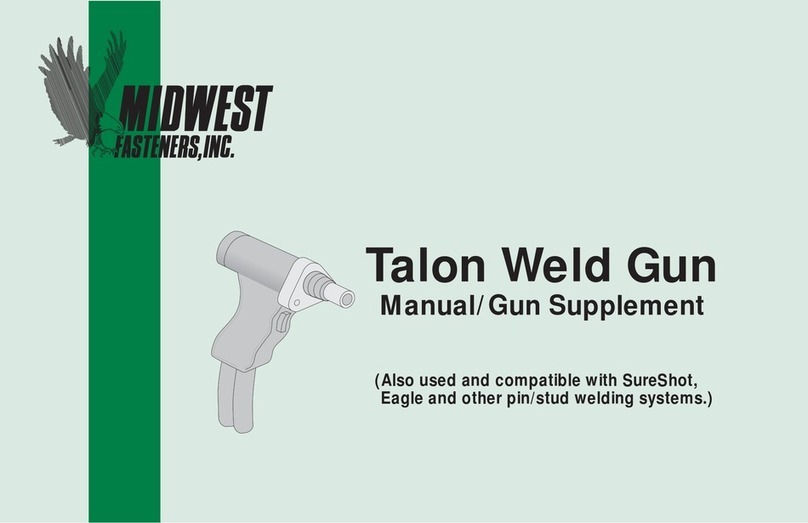
MIDWEST FASTENERS
MIDWEST FASTENERS TALON User manual

MIDWEST FASTENERS
MIDWEST FASTENERS EAGLE User manual
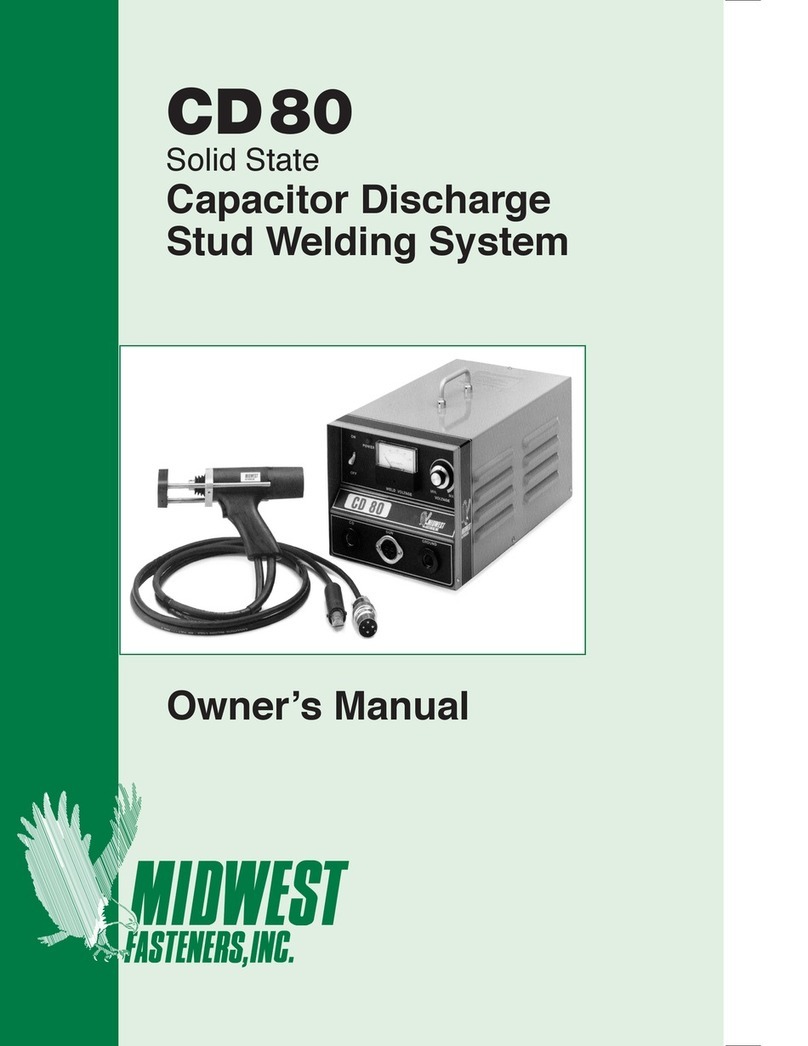
MIDWEST FASTENERS
MIDWEST FASTENERS CD80 User manual
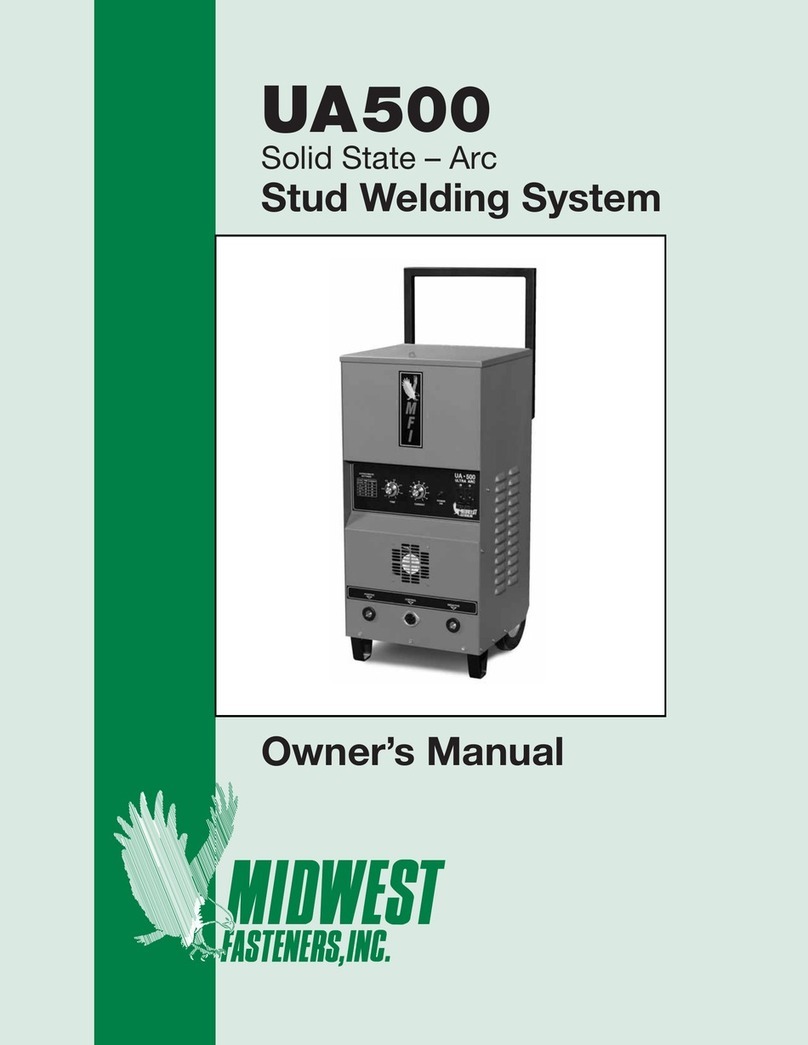
MIDWEST FASTENERS
MIDWEST FASTENERS UA500 User manual

MIDWEST FASTENERS
MIDWEST FASTENERS sureshot User manual
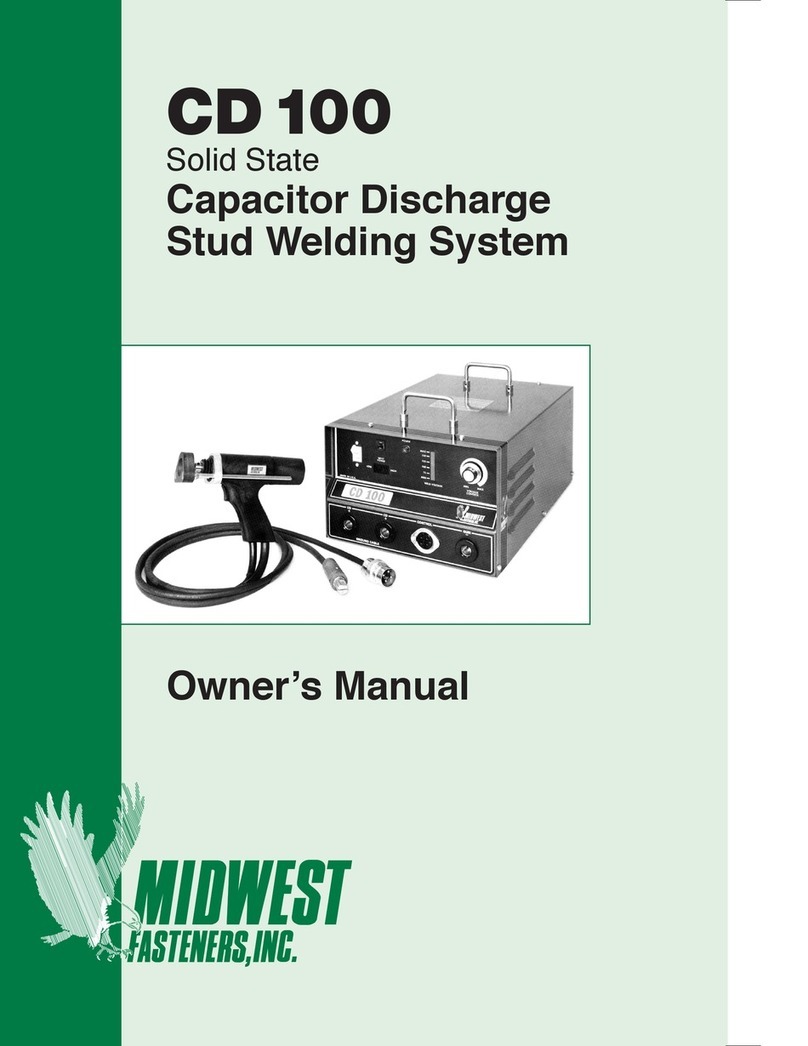
MIDWEST FASTENERS
MIDWEST FASTENERS CD 100 User manual
